Just because gardening is an exercise in patience doesn’t mean gardeners are patient. If you want to join the grow-it-yourself club, and you don’t want to wait, you can turn your unproductive, resource intensive lawn into a ready-to-thrive vegetable garden this weekend.
It’ll take some work, but probably less than you think. It’ll take money – but again, maybe less than you think. And in 48 hours, you can be sowing your first seeds in an attractive and easy-to-maintain insta-garden. Let’s get going.
Step 1: Find the perfect gardening location
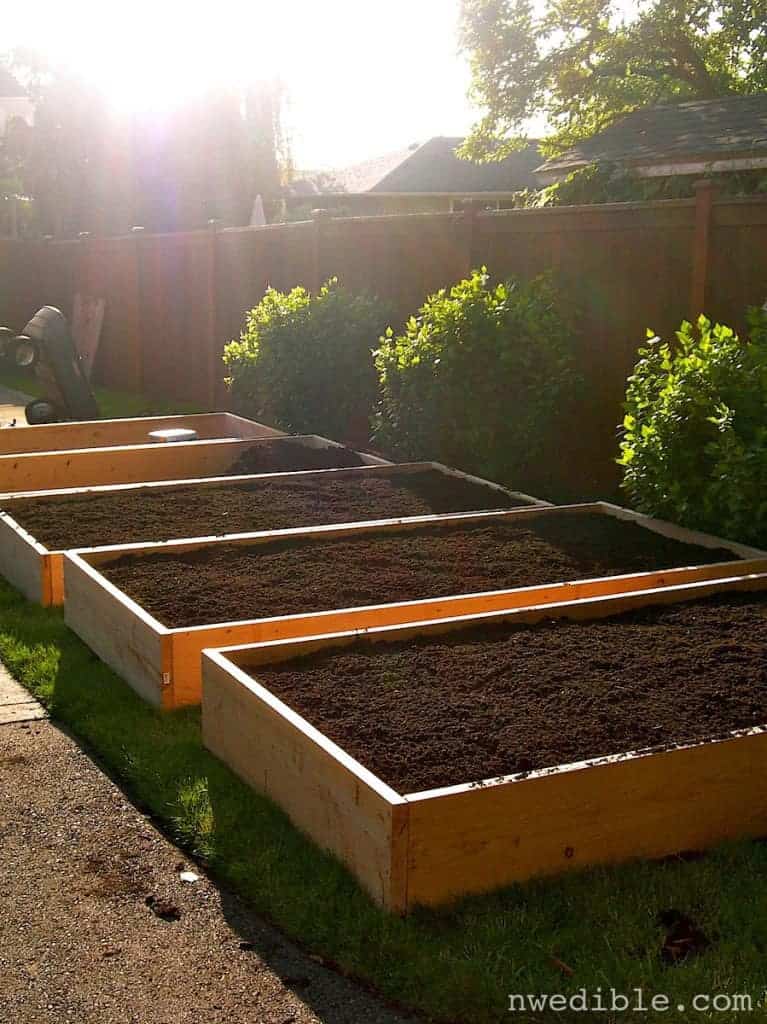
Ok, “perfect location” is a gardening unicorn – it doesn’t actually exist. So find the closest thing to a perfect location that you can.
What To Look For In A Garden Location:
- Full Sun – Those lists of veggies that will grow in shade are basically making the best of a bad situation. For the best garden you want as much sun as your yard can muster. If you live in Las Vegas or L.A., maybe the rules are different, but in general, annual vegetable crops need sun – and lots of it – to really thrive. Remember, you can always add shade, you can’t add really add more sun.
- Close to Home – The best gardens are visited often! The days of keeping a garden “way out back” are long over. Place your garden on a natural path to and from your home, or locate it just out the back door. When a garden is convenient, you will take better care of it, harvest more, and keep it more attractive.
- Level Ground – If you want to make an insta-garden, you don’t have time to install a complex terrace system. Try to select an area that’s fairly level. If you’re dealing with a gentle slope, that’s ok, but if you’re gardening on the side of a mountain this might take two weekends.
- Favorable Microclimate – Look for an area that will be sheltered from the worst of the winds and isn’t in a depression or at the bottom of a slope where cool air will pool. In cool climates, if you build your garden on the south side of the house or near a driveway, you’ll reflect heat and light to your plants and extend the growing season.
- Think Irrigation Before You Build – a garden that requires 127 trips back and forth across the yard with with a watering can is going to die in July. Make it easy to keep your garden appropriately watered by planning out your irrigation right from the start. A soaker hose hooked to a simple garden timer will automate your watering and help ensure success.
Step 2: Deal With Your Grass By Not Dealing With Your Grass.
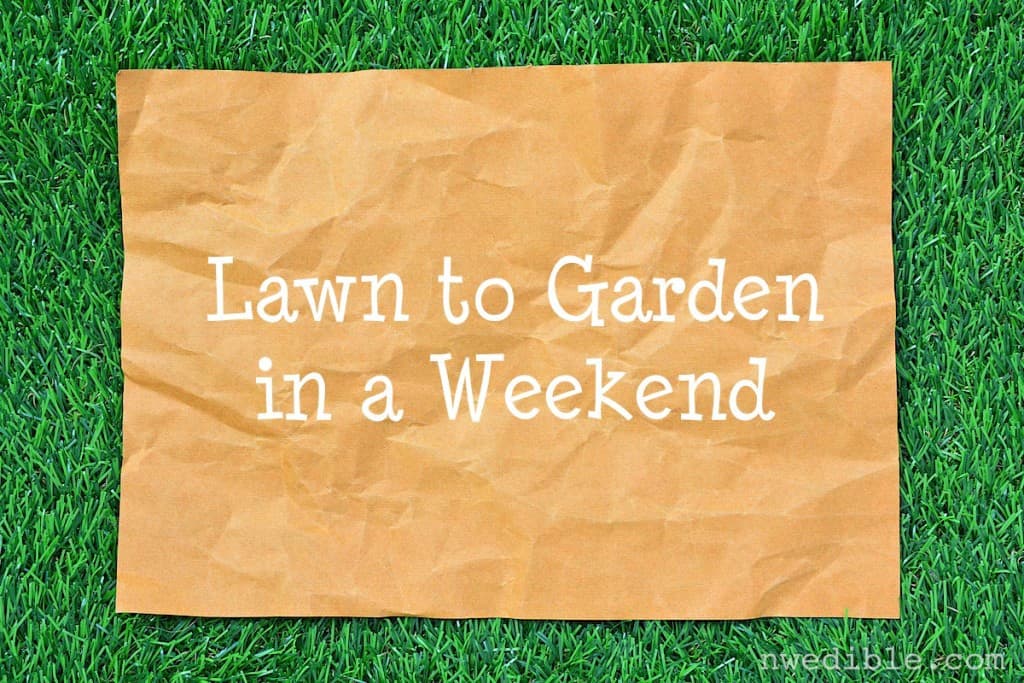
In many areas of the country, you can install your garden right over your lawn, so don’t rip up that grass – smother it! Decomposing grass becomes wonderful soil enriching compost. (Read more: Stop Ripping Up Your Lawn To Grow Veggies)
The raised beds you’re going to build for your insta-garden are more than deep enough to smother out typical fescue-type lawns and will provide plenty of root room for your first season’s crops. So, as long as you aren’t building your garden over Bermuda grass or another highly invasive grass, you can simply build your garden right on top of your lawn instead of ripping it up.
For additional security against weeds, just line your garden bed with plain brown cardboard before filling with soil.
Step 3: Build Wooden Raised Beds

Keep this simple, because cheap raised beds still grow great food. I recommend building open-bottomed rectangular frames out of inexpensive dimension lumber.
A 4×8 foot box requires 3, 8-foot long pieces of lumber. Cut one board in half for the end pieces, and screw everything together with good quality deck screws. That’s really all there is to it.
Sturdy 2x10s or 2x12s work well for raised beds, or build two boxes with 2x6s and stack to make a bed about 12-inches deep.
We build all our beds out of hemlock or fir – the standard cheap-ass 2-by-whatever lumber you can get at the Big Box Stores. The exact wood species may vary by location but the point is – this is the cheap stuff. Even in our extremely wet, wood-destroying climate, we get 7 to 8 years out of our beds before they fall apart. I imagine gardeners in dryland climates might see a decade or more from beds like these.
When the frame to your raised bed finally needs to be replaced, it can be buried to make a hugelkultur style bed, burned in a firepit or woodstove, turned into biochar or chipped for mulch. It doesn’t have to go to waste just because it’s no longer useful as a garden bed frame.
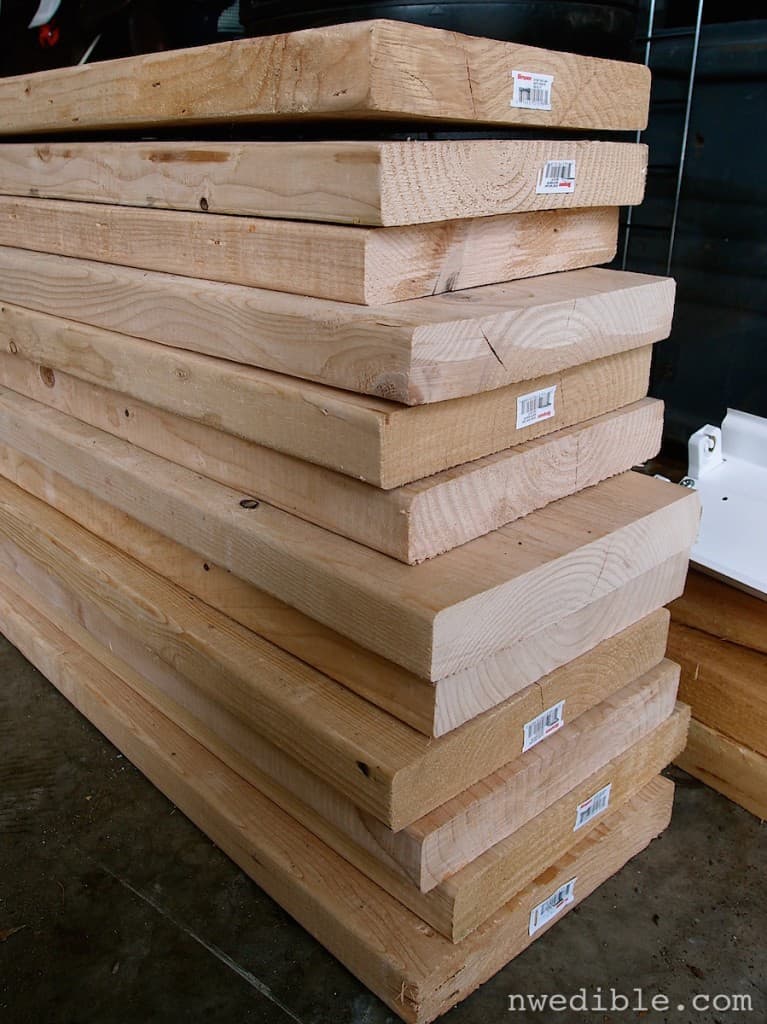
Thinking of going rogue? You can make your raised bed any way you like, but consider the following:
Materials
I skip the pressure treated lumber for edible gardens. Although modern pressure treated lumber isn’t quite so icky as the old copper and arsenic treated stuff, it’s not exactly benign. Pressure treated lumber resists insect attack, fungal decomposition and rot by being impregnated with many of the same chemicals I refuse to apply directly to my vegetables.
So this is a judgement call, but it doesn’t make sense to me to grow organic vegetables right next to wood that’s been soaked in fungicide.
Cedar or Redwood would be longer lasting than hem/fir but is far, far more expensive and harder to get in thick, dimension-lumber sizes. One other naturally rot-resistant wood we’ve used is juniper. Juniper timbers and boards are a great and very sustainable wood option for garden structures, but this wood is also fairly expensive and hard to find in many places.
Size
Keep your beds no more than 4 feet wide so you can easily reach into the center to tend them. If you can only reach the bed from one side, stick to 2 feet wide. Much wider and the beds are just too wide to comfortably reach into.
You can make your beds as long as you’d like. Small space gardeners might like a single 4×4 bed, while someone with a long, narrow lot might build a 24-foot-long, 2-foot wide bed. You have to adapt to your location, but all else being equal, building and working with standard 4’x8′ boxes is very convenient.
Since you’ll be using these beds to smother existing grass, you want them at least 8 inches deep, and 10 or 12 inches is better.
Step 4: Position Your Garden Beds

Fiddle with your garden bed boxes until they are located exactly how and where you want them. Make sure the bed itself is level – prop up one end with bricks or rocks if needed.
If you plan to grow a lot of crops vertically, on trellises, align your garden bed(s) east to west. This puts the trellis to the north, so crops grown vertically don’t shade out the crops in front. If you don’t need a long stretch of trellis, alignment isn’t that big of a deal with raised beds. You can place them N-S or E-W.
Because the plants themselves will be planted in more of a grid inside the beds, either alignment will work.
Once you settle your raised bed frames into place in that perfect spot, if you want, line the bottom of the raised bed with plain brown cardboard and wet down the cardboard, so that it collapses. This will ensure the grass is well smothered and helps prevent weed growth up into your new garden bed.
Step 5: Fill Your Raised Beds
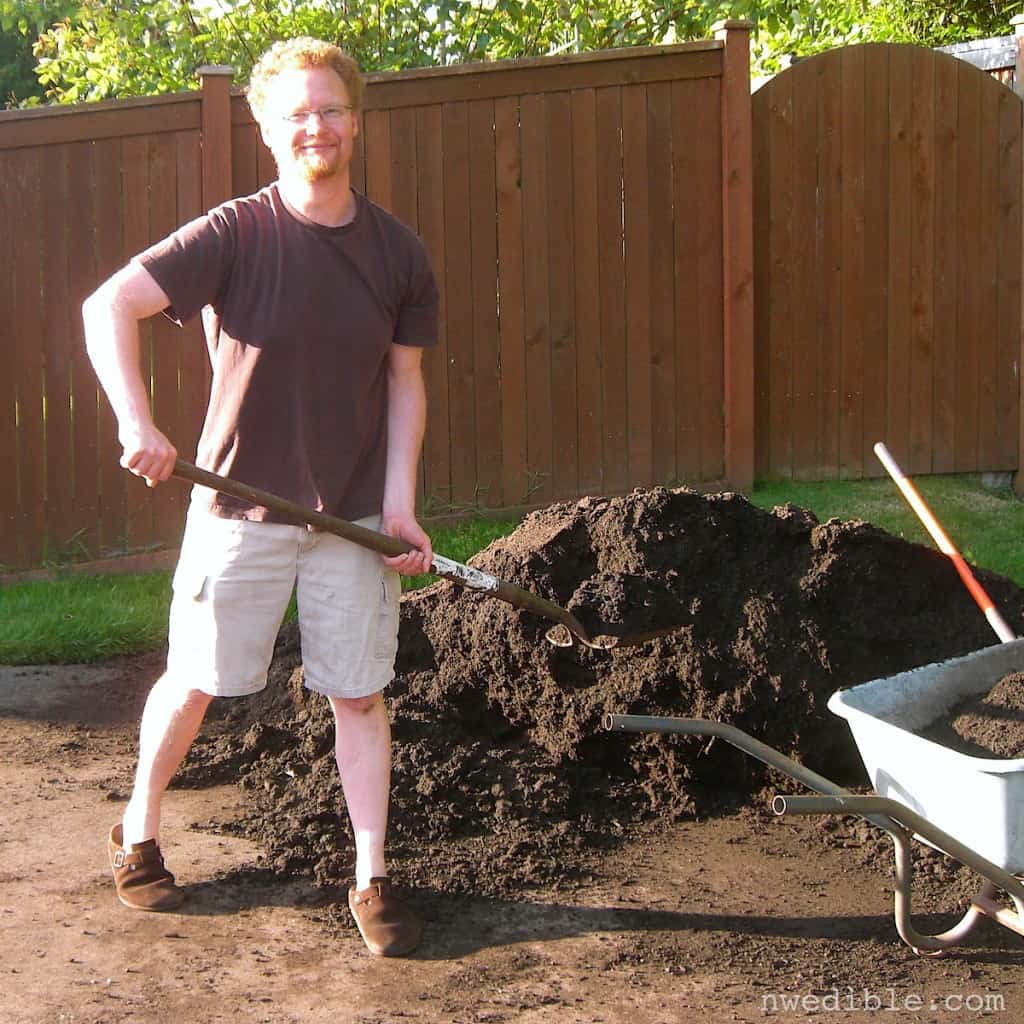
Now the fun part! (Or hard part, depending on how you look at it.)
Fill your garden bed frames with high quality purchased vegetable-growing soil. This is not the same as topsoil, fill dirt or compost. Your soil company may call it 3-way-mix or a vegetable growing blend.
You’ll probably want to buy your insta-soil by the cubic yard – it’s almost always cheaper to buy stuff like this in bulk than by the bag. One cubic yard of soil will fill one 4’x8′ garden bed about 10 inches deep. If you need a different quantity, use this calculator to figure out how much you’ll need.
As you fill your beds, amend the soil with lime if needed to adjust the pH. The company from whom you purchased the soil should know what type of lime is best for your climate, and how much to add per square yard. It might not be necessary to add lime at all – so if you’re not sure, wait until you see how your plants grow.

What To Look For In A Good Vegetable Soil Mix:
- A mix that’s about equal parts compost, coarse sand and high quality loam topsoil. Some composted dairy manure or vermicompost in there is a very good sign, too.
- Buy from for a company that can tell you exactly what’s in their recommended vegetable growing soil and if it’s been pH neutralized with lime. (And how much lime to add per cubic yard if it hasn’t been.) If you can feel and smell the mix before you buy, so much the better.
- If you are in an arid climate, look for a moisture retentive soil. If you are in a wet climate, fast-draining soil is important.
- Compost and manure you are comfortable with. Some compost may contain bio-solids (sewer waste) and commercial manures might come from feedlot-type operations. Ask some questions before you pull out your credit card, and if you have ethical or other concerns about the source of the soil, keep looking.
Step 6: That Cooling Off Period
Once your beds are filled with high quality vegetable-blend soil, there’s just one more thing. There’s a good chance your soil came to you literally steaming from microbial activity. You don’t want to pop your plants in soil that’s actively hot, so give your beds a day to just cool off.
Once the soil is not overly warm to the touch, it’s Grow Time!
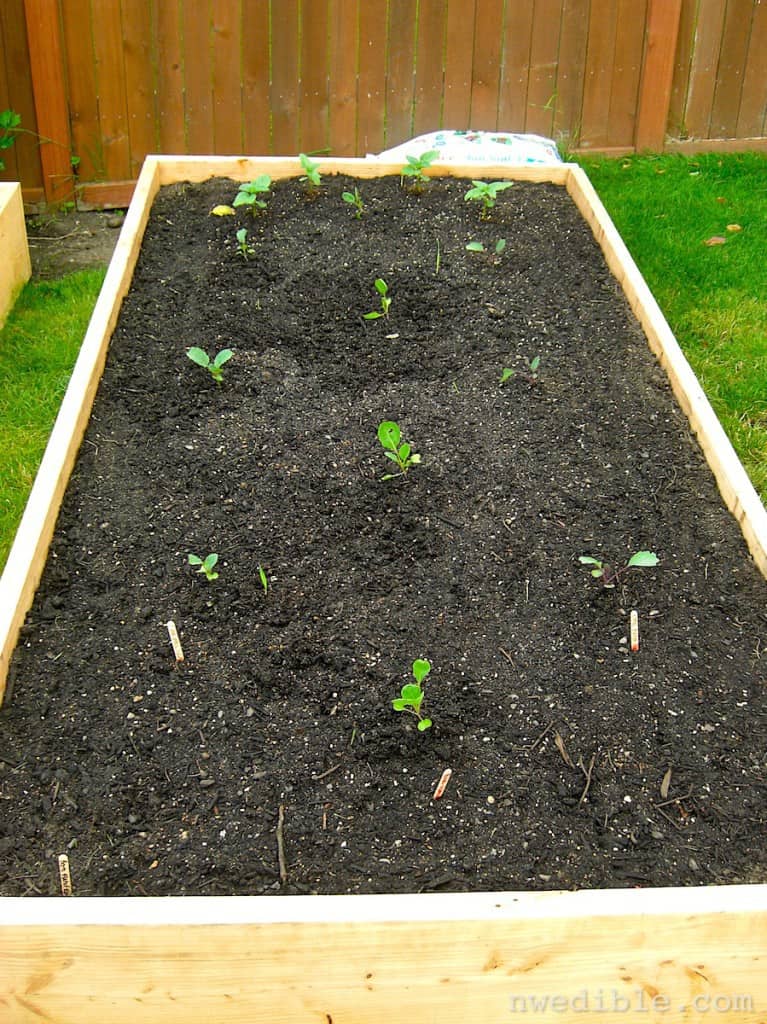
Congratulations!
You’ve got yourself an attractive, not-too-expensive garden and you’re ready to grow. Not bad for a single weekend, huh?
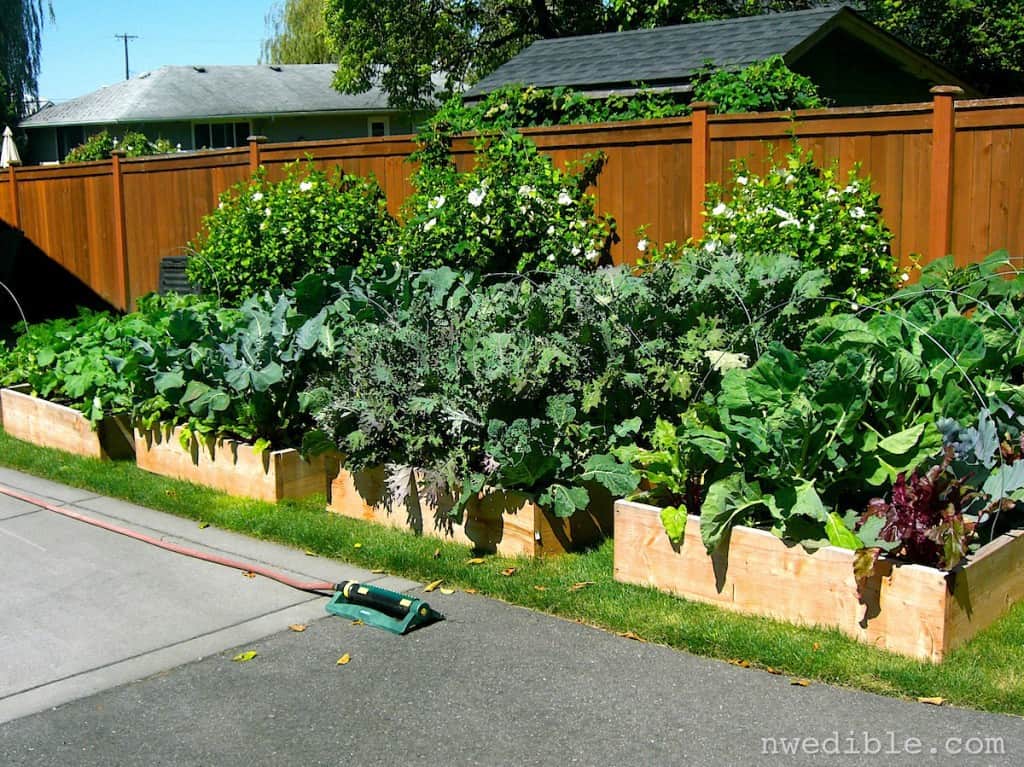
How Much?
I estimate one complete 4’x8′ insta-garden bed built and filled as described here will cost approximately $60 to build and fill. Exact costs will vary based on local prices for lumber and vegetable gardening soil mix.
Materials You Will Need For One, 4’x8′ Garden Bed
- 3, 8-foot long, 2×10-inch Hem/Fir dimension lumber – $24
- 12 coated deck screws or equivalent – $2 ($10 for a 1-pound box, you’ll use about 1/5th the whole box)
- Cardboard, to line bottom of bed – free
- 1 cubic yard high quality vegetable blend soil mix – $33
(Order the soil mix beforehand so it’s delivered or ready to pick up at the right time for your lawn-to-garden project.) - Garden lime – $1
Estimated Total Cost: $60
According to Mother Earth News and Rosalind Creasy, in these 32 square feet of growing space, you can expect to grow about $230 worth of organic vegetables and herbs. Here’s additional information about the financial return of a vegetable garden.
Do it right, and vegetable gardening is a hobby that really pays!
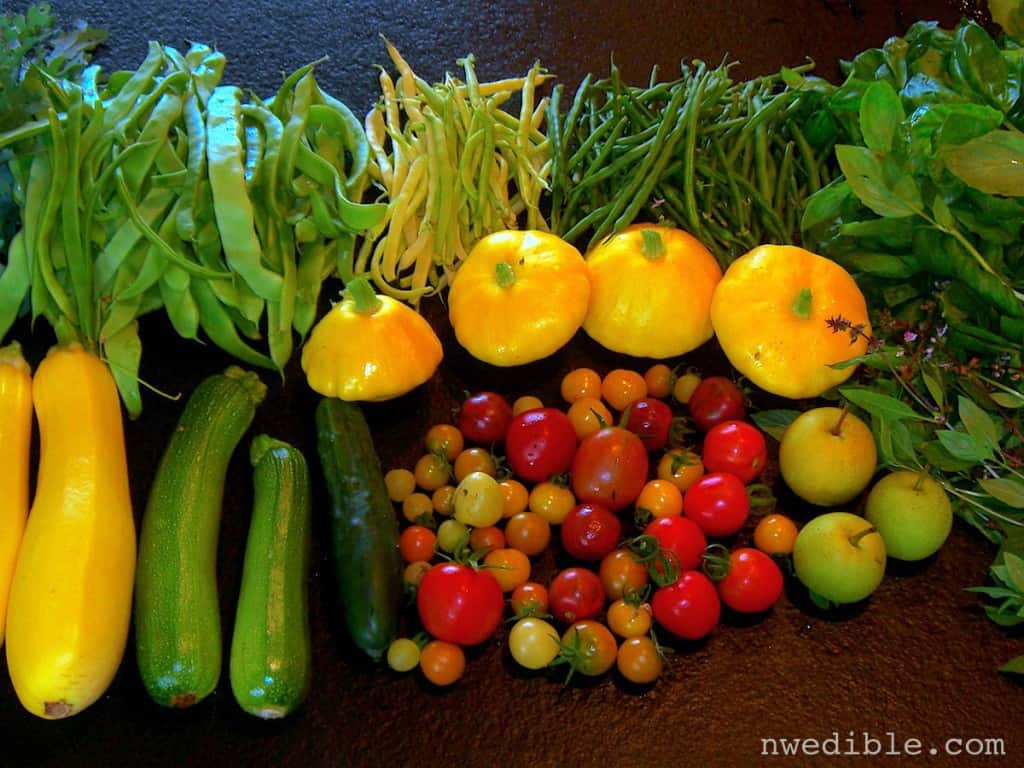
Pin It!
Pinning is good for you. Not as good as homegrown snap peas, but close. Here’s a Pinterest-friendly graphic you can share with your friends:
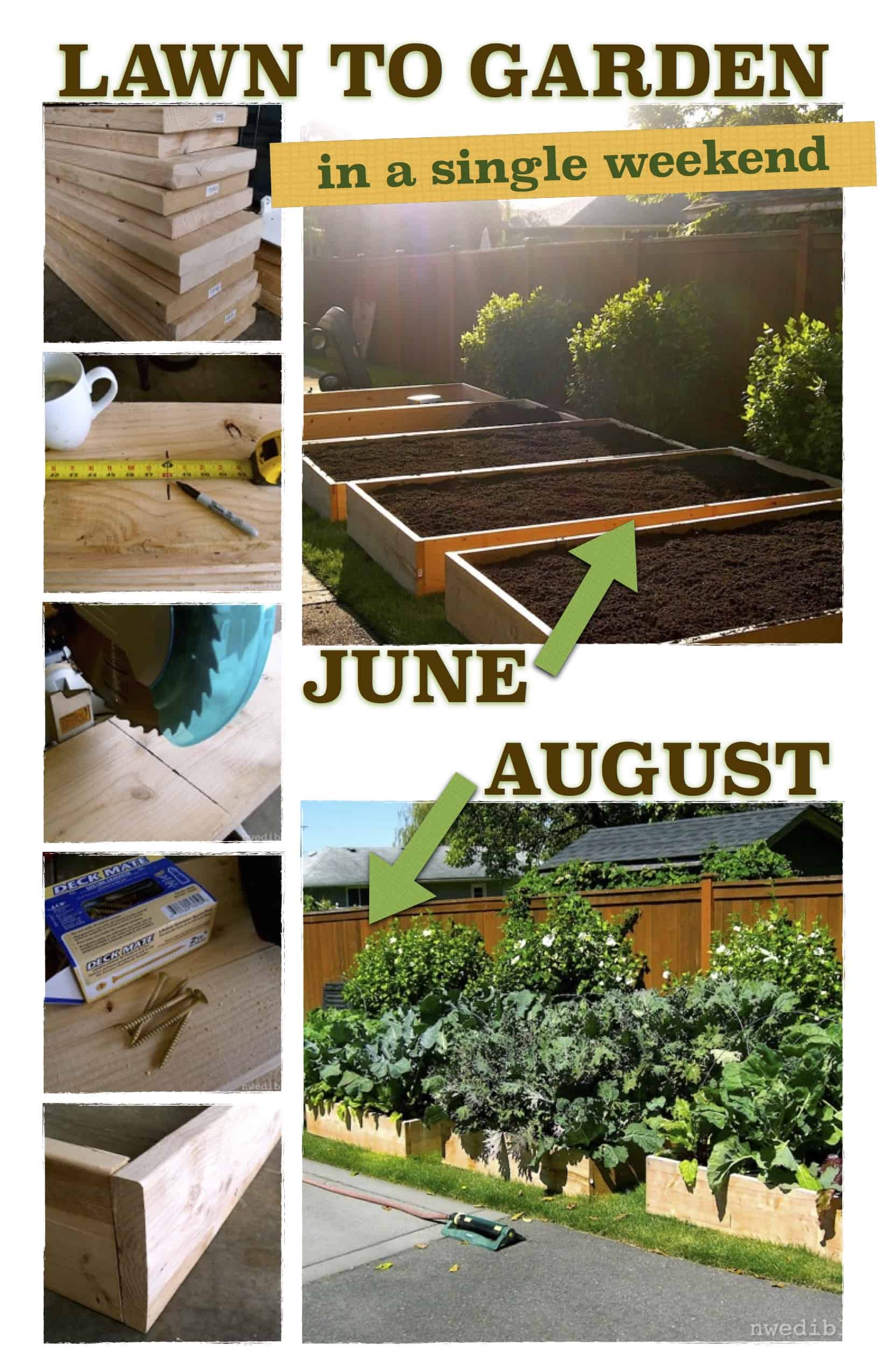
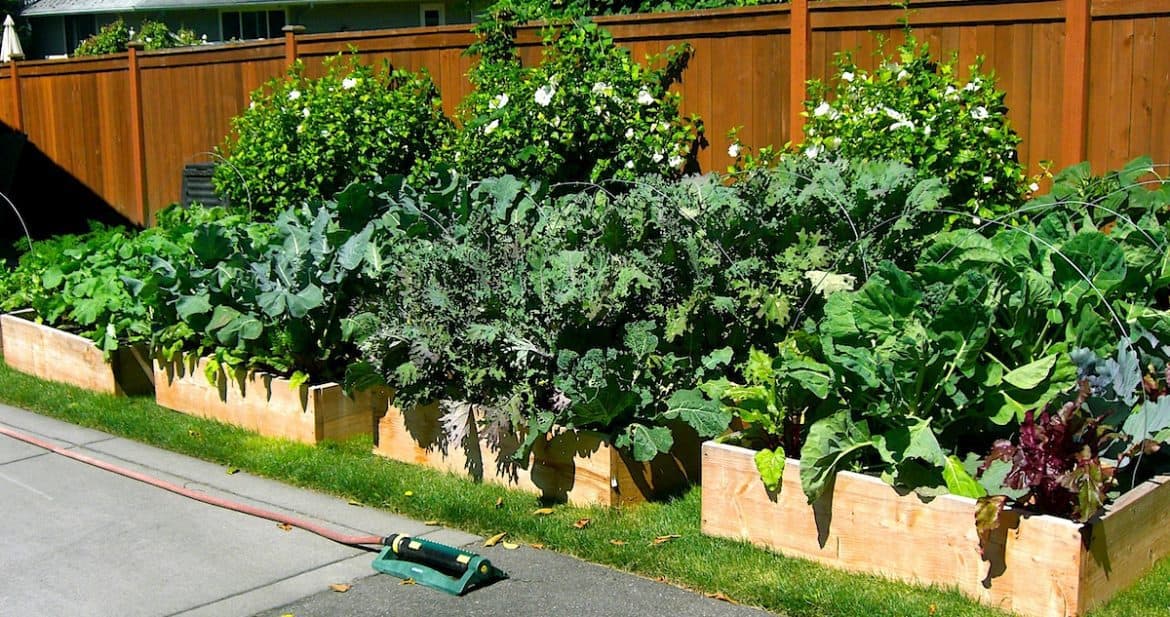
24 square feet? Am I missing something? A 4×8 bed would yield 32 square feet, yes?
No, it was clearly ME who was missing something…3rd grade math. Thanks for the catch. 🙂
One question that was asked was “how do you mow between the raised beds?” The honest answer is that we don’t – if you look at these beds today, you’ll see that the space between them are all mulched down with woodchips. As pretty as the grass-between-beds look is, it seems to either require a gallon of two stroke mix and a line trimmer or an aeon on your knees with old school grass clippers to maintain. Hench the mulch.
It really is that easy! My first year looked like those beds, with a basic spray nozzle at the end of my regular yard hose. Setting up soakers and a timer is MUCH easier, and only slightly more expensive.
You can do it in a couple of hours with lazy beds. (Not quite the same finished appearance though.)
I was either lazier than that, or much more industrious, depending on how you look at it 🙂
My backyard lawn is now completely gone, which we did without building raised beds. I bet you’re familiar with the “Back to Eden” gardening method? (b/c even though I only found you recently, you talk about mulch and woodchips in your garden, though which of course is not BTE-only). The hard part was moving a truckload of woodchips from street level UP a flight of stairs, and around to the backyard. Yow. That was last fall, so I’ve blocked it partly out of memory. But the fun bit, now there’s no lawn, and a developing garden, including that this morning I counted that 11 of the blue organic potatoes that I planted are starting to sprout! Super-exciting, as this is the first year I’ve ever tried to grow potatoes.
Anyway, you’re a recent find for me, and just wanted to say “hi” as I’ve been so enjoying your blog (I’m in Seattle, so your gardening timing guides and other advice fit me perfectly).
Blessings,
Dr. Deborah
Yes!! That’s almost exactly what we did last weekend! We built 4, but we dug down 6-8″ and put wood on the bottom, then the dug-out soil, then filled with veggie mix. We also built your tunnel cloches. We have space for 16, so we’re going to build a few every week or two until they’re all done! Thanks for answering my question about how that dimensional lumber was working–makes me glad we decided to use it.
I’m still puzzled by irrigation. I’ve reread your posts on automating irrigation, and I’m just not sure how exactly to do it… I do have my “food forest” area on a drip system with an Orbit timer hooked to the exterior faucet. I was looking at the link to your fancier timer and wondering how to use it– did you convert a sprinkler system? Or hook it to an exterior faucet? Does it plug in or have to be hard wired in? I’m probably going to be hand watering or using soaker hose in the raised beds for now.
Any chance of an “irrigation made very, very simple” post? Or perhaps a bed by bed photo journey of how your irrigation works? How many switchbacks of the soaker hose around plants, how long to leave it on, how often for different veggies, etc…
Love this, thank you!!
I ditto Staci,
I’d love an irrigation post. That’s one thing every year I say I’m going to do then I start putting stuff in the ground before I get irrigation figured out. EVERY YEAR. I even have a ton of soaker hose sitting RIGHT THERE. Sigh.
A step by step irrigation for dummies would be fantastic!
I keep reading your posts even though I have ZERO full sun areas. sigh. I’ll just continue to jealously follow your progress
Kate; why not find a community garden close by? Or maybe a friend has a area that you could rent for “vegies”. All you have to do is ask.
Garden On!
Just wanted to second what Carolyn said, Kate. Before I was able to do “enough” gardening on my own & with hubby, I posted on Craigslist and at my alma mater’s message boards looking for a gardener who didn’t have space to do their own garden. I wanted somebody to help, possibly drive the process, but with whom I’d share the work and the proceeds. Like they’d pea-patch in my backyard. Didn’t find anybody. But that means some people out there in Seattle think this is a good idea :). I hope you find a patch for growing things soon!
Where are you in Seattle that you don’t have to account for delivery fees for the soil? One of the main reasons I went with hugelkultur inspired raised mounds was not needing soil delivered, since it looks like it runs about $100 per delivery to my central Seattle neighborhood. Of course, now I’m trying to figure out how to get enough compost to amend the soil I have without paying a ridiculous amount (I don’t drive and I don’t have access to a truck).
For small purchases of bulk soil, if you don’t have a truck, honestly the best course is to borrow one truck. If that’s not possible, renting one of those Home Depot type “trucks by the hour” can be a good option. Even factoring in the rental of the truck, it’s usually cheaper than paying delivery fees in the city. Another option is to split deliveries with like-minded gardening neighbors to minimize the impact of the delivery fee. Edit: apparently missed the part about you not driving. Sorry. Yeah, that’s a rough situation. Got any good friends with a truck who want to help you out for homemade pizza or something?
I think we’re going to try to put in as many beds in one go as possible to make getting a delivery worth it. I’ve already started building two hugelkultur mounds but everyone seems to be concerned they’re ugly… so we’re going to get the friend with an SUV to bring lumber and build frames for them. I guess I can get a good experiment going to compare a hugel bed with our own soil (+ compost), a hugel topped with vegetable growing mix, and a couple of quick beds built over the grass and filled with the veggie mix only.
We did it! Framed two hugelkultur beds to 4’x13′ and 4’x11′ and filled them with more soil, so now they look “pretty” and like conventional raised beds, and built two 4’x8′ beds right on top of the lawn. The whole thing only took about 2 hours with five of us doing the work. The best part was my housemate’s Fiat 500 with the 13′ boards tied to the roof rack.
Lack of funds and the fact that raised beds are a pretty bad idea here (dry out too fast) means I tilled the grass under and did in-ground beds. Means weeds are a fun thing to keep on top of, but my fancy new Dutch hand hoe and collineal hoe should make them quick work.
Right now the big project is bunny fencing. Oy. Last year they left stuff well enough alone but I can’t get ANYTHING started this year, so seedlings are all waiting until this weekend when I can build a 100′ fenced perimeter.
I think I love you. Well, at least I love that you posted this I still have plenty of time before our last frost date but I’ve been waffling about putting in more beds. Thanks for the step by step approach so it doesn’t seem so daunting!
I’m so glad someone else advocates using construction lumber! We use 2 x 6s and they last for years, and also scout the Habitat re-store, sometimes they have really great old lumber (like douglas fir 2 x 10s) for just a couple of bucks. On cheaper wood we paint the ends with some leftover latex paint, just to hopefully stop a bit of moisture from creeping in the grain. And I started out just mounding soil, you don’t even need structure necessarily, if you want to get started and don’t have the time/cash to build them yet.
What about using Tagro (biosolids) soil in a vegetable garden? I am not really sold on this but so many people talk about how they just think it is great! Leary of the heavy metals and pharmaceuticals.
Carolyn
I lined my beds with plain cardboard first to kill the grass and weeds.
I have also decided to end my ‘mental’ war with dandelions. The bees love ’em, they always come back, my kids will forever be in love with blowing seed puff-balls, I can’t win. Nature has decided they are here to stay. To keep them out of the active garden bed I just give them a quick stab with my trowel and toss em out. I feel better about my relationship with weeds (hahaha) if I keep a forgiving attitude and love all the aspects of gardening!
We did this some years ago but killed the grass and weeks with black plastic covering beforehand which at the time was what a friend suggested we do. After many summers of trying to deal with weeds between the boxes, even though we had put down ground cover and gravel, trying to deal with far too many weeds and &#%^&$# morning glory that made it’s way to the raised boxes thanks to a neighbour who did nothing with their yard, I gave up. The boxes were removed last fall and grass has now been planted in their place.
IF I was ever to do this again, there would be a layer of black plastic, a layer of gravel, then the raised boxes placed, with the boxes themselves lined with black plastic before adding soil.
That said, your raised beds look awesome and how great it is that you have the dreaded weeds under control. Something to be proud of indeed.
I am interested in building some beds on a lawn presently COVERED in dandelions! Would this technique work well enough to kill off the dandelions below, or do I need to eradicate them beforehand (ie: dig them all out)? I want to get started gardening as soon as possible and I don’t have a ton of free time to dedicate to the dandelion issue! Thanks for any advice!
jes
How much space between beds? These look pretty close together. So you probably can’t fit a wheelbarrow between them? Does that work out OK? I always want to greedily put them as close together as possible, but am in new home where we are starting from scratch, and am wondering about leaving ample space between rows this time….but if it works fine without for you, I’d love to hear logic.
Just stumbled across your website and feel like I have found my kindred spirit! You are living the life this country girl in the city is longing to live. Since my divorce last year, I have stepped up my veggie gardening and have started raising butterflies, but I am yearning to do more. I desperately want chickens, but live in a city where you can’t have them unless they are 100′ from the nearest dwelling. My lot is a urban lot of only 6,600 sqft so this isn’t possible. I’ve joined the Hens for Houston movement, but they’ve been working for years to get the ordinance changed with no luck. 🙁
Nonetheless, I am moving forward with expansion of my veggie garden. Working on a plan for the beds now and hope to work through the summer to transform my small backyard into my little inner city farm! My son who is 2.5 is so excited! I love that he will grow up knowing where his food comes from.
Thank you for your inspiration!
Joanne
Houston, TX
These look very easy to make. I’m doing raised beds this year, except for my fall garden. I like how you just toss the dirt over the grass. That is a great tip! Cuts out the extra step. Thank you!
Hi, I know this is an older post but I’m looking to start a garden in my back yard. The best place to put it would be where there is already a random cement patio (i think prior owners had a hot tub there). We originally tried to jack hammer it up but it had rebar underneath and was too much for two skinny kids to do on our own. Its probably only about 6-8 inches deep. Would it be okay to start a raised bed there? Do you think it would allow for appropriate drainage? Any thoughts would be helpful!